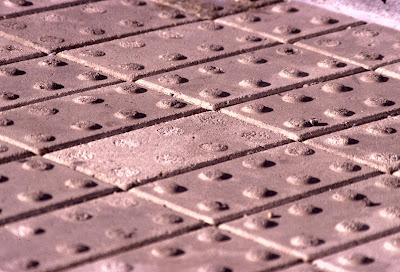They are almost ubiquitous on sidewalk curb ramps. They warn people with vision impairments that they are about to cross with a vehicle path, usually a roadway. They are mandated by the Accessibility Guidelines of the Americans with Disabilities Act. They reflect the budgets and design criteria established for the places where they are used. Many materials are used for the truncated domes: Cast plastic sheets, cast concrete, molded bricks, precast concrete pavers, quarry tile, and carved stone. Have you ever wondered how they weather over time?
 |
| Cast plastic tactile warning pad, cast into concrete base |
 |
| A typical curb ramp having precast concrete pavers for the tactile warning |
 |
| Precast concrete pavers |
 |
| Truncated domes on these bricks provide tactile warning for people with visual disabilities |
The question occurred to me a few months ago while walking around a neighborhood in Downtown Baltimore and I noticed that the truncated domes had appeared to have worn off several curb ramps which had beige colored brick. Most, but not all, of the curb ramps had the same condition. The domes were worn off the base brick. It made me wonder, is there was a defect in these beige colored brick?
 |
| Now how did that brick in the middle of the field loose all of its domes while the surrounding brick are mostly intact? |
 |
| Notice how many of the truncated domes are worn down or missing with the only thing left being the circule from where they were located. |
 |
| Red-brown pavers with all domes intact |
Further excursions around Downtown Baltimore and Downtown Washington seemed to reinforce the idea that the beige colored brick seemed to have an inherent wear defect. A cast plastic sheet across the street from the beige bricks seemed fine. Two shades of red
and brown brick used commonly elsewhere in Downtown Baltimore were mostly fine; only missing an occasional dome. Precast pavers of different colors used in Downtown Baltimore and Downtown Washington seemed unworn. The granite stone in the federal area around the White House and around several Class A buildings in DC's "Golden Triangle" weren't showing any signs of wear.
 |
| Red brick pavers, with some of the truncted domes worn |
 |
| Red-brown brick pavers, with some worn truncated domes |
 |
| Precase concrete pavers |
 |
| Granite paver |
Then I walked in front of the DC Convention Center and saw a clue. The precast pavers in one of the curb ramps had a distinct pattern of missing domes which looked like they had been shaved off, possible by a snow plow blade. Had the beige colored bricks been shaved of their domes? Maybe. This brought several questions:
 |
| It looks like something slid in from the roadway (to the left) and sliced off the dome in these precase concrete pavers |
• Who is responsible to maintaining the domes in functioning condition? Probably the adjoining property owner, since they usually have responsibility for the maintenance of the sidewalk in front of their property.
• Should property maintenance personnel be trained in how to remove snow and ice from truncated dome pavements? This seems like a reasonable probability, since different flooring materials require different cleaning techniques. If you have ever cleaned smooth vinyl or rubber flooring and then cleaned seamless aggregate surface flooring, you know that cleaning the seamless aggregate surface flooring needs brushes rather than a sponge or cloth mop used for smooth vinyl or rubber flooring.
• When does the truncated dome paver lose its effectiveness as a tactile warning surface? If one dome is missing on a paver, does that render the paver in violation of the ADA? At what percentage of lost domes does the paver need to be replaced? Sounds like questions for the Department of Justice responding to a civil rights complaint.
• Should a test method be developed to determine the resistance of the dome against shear?
